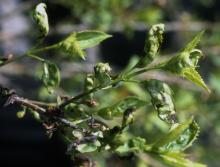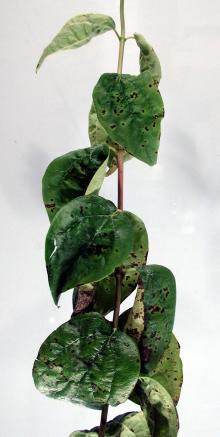Cause Pseudomonas syringae pv. syringae and P. s. pv. philadelphi, bacteria that overwinter on stems and buds. The disease is often a problem in years when spring weather is cool and wet.
Symptoms Small, water-soaked spots that rapidly become necrotic. Spots may be angular and have a slight chlorotic halo. Leaves may be distorted from the presence of numerous spots. Severely infected leaves drop. Terminal shoots can become blighted and show a shepherd's crook. Plants also may be stunted.
Cultural control
- The cultivar Philadelphus x lemoinei 'Lemonie' was resistant when artificially inoculated.
- Protect from rain and frost, if possible, in early spring. Plastic shelters have been as good as or better than chemical methods against this disease on other crops.
- Remove and destroy infected leaves and shoots.
- Maintain adequate spacing between plants for good air flow.
Chemical control Bacteria resistant to copper products and antibiotics have been detected in many Pacific Northwest nurseries. Fixed coppers may help, but none are registered for this crop. Use the following on a few plants and observe for phytotoxicity before general use.
- Bonide Copper Fungicide at 8 oz/3 gal water. Group M1 fungicide. H
- Phyton 27 at 1.5 to 3.5 oz/10 gal water. Group M1 fungicide. 48-hr reentry.
Reference Kennedy, B.W., Froyd, J., and R. Bowden. 1984. Bacterial blight of mock orange (Philadelphus spp.) caused by Pseudomonas syringae. Plant Disease 68:916-917.



